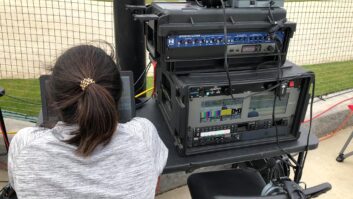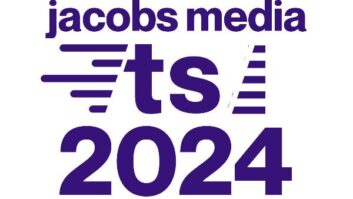IBOC Update � Feb 8, 2006
Feb 8, 2006 10:51 AM, By Mark Krieger, CBT
Stay up to date on the latest IBOC news, business and technology information with the twice-monthly newsletter from Radio magazine.
Index:
- DRM to Present Seminars, Technical Papers at NAB2006
- NAB Offers HD Radio Workshop Online
- KUOW Multicasts Received Over Seattle Cable System
- Boston Acoustics Cuts Recepter Radio HD Price
- Ibiquity Certifies Audemat-Aztec AM HD Radio Monitor
- IBOC by State: Arizona
- HD Radio Alliance Organizes Engineering Cooperative
- An Introduction to the New Language Surrounding HD Radio
To receive these articles twice a month in your e-mail, subscribe to the IBOC Update – Insight on HD Radio e-newsletter. Click here to subscribe.NewsDRM to Present Seminars, Technical Papers at NAB2006
While HD Radio is likely to dominate the radio hall floor at this year’s NAB convention and engineering conference in Las Vegas, it won’t be the only digital radio game in town. For the first time at NAB, a panel of Digital Radio Mondiale (DRM) front-liners will present how-to seminars for broadcasters called “DRM: The Basics in 90 Minutes.”The free seminars will be hosted by DRM members Continental Electronics and Harris Corporation’s Broadcast Communications Division, and will take place at their NAB exhibit booths on April 24, 25 and 26. Prior registration is required.DRM will also be on the agenda at the 60th Annual NAB Broadcast Engineering Conference, as two DRM presentations will be presented in the Digital Radio Worldwide session from 10:30 a.m. to noon on April 24.The first paper relates to DRM VHF broadcasting development, as DRM Technical Committee Chairman H. Donald Messer, PhD presents “DRM Progress in Developing a Capability in the Broadcasting Bands above 25 MHz.”The second paper will cover pioneering work on monitoring the performance of digital radio delivered on HF over wide geographical areas, as Andy Giefer of DRM-member Deutsche Welle presents “Digital Shortwave Reliability Analysed with Deutsche Welle’s DRM Monitoring.”And on April 25, John Sykes of the BBC World Service (a DRM member) will present a paper introducing a simplified digital ID system for AM radio. This system allows existing AM broadcasters to signal their station ID to a new generation of hybrid digital and analog receivers, thus keeping them on the “digital dial.” Look for “An AM Signalling System (AMSS)” in the Emerging Technologies for Radio session from 1:00 p.m.-5:00 p.m.Persons seeking information and seminar registration for DRM’s schedule of events at NAB2006, can contact DRM’s Project Office at [email protected].NAB Offers HD Radio Workshop Online
The National Association of Broadcasters (NAB) is now offering its “NAB HD Radio Workshop Webcast” online to NAB members and non-members alike. NAB touts the online presentation as “a unique opportunity for technical professionals to learn how to plan, budget and implement Ibiquity Digital Corporation’s HD Radio AM and FM digital radio technology.”The webcast includes more than 16 hours of material originally presented live at last fall’s NAB Radio Show HD Radio workshop, including video and audio of the speakers, with a separate presentation screen that displays all accompanying presentation graphics. Purchasers of the service receive a password that allows unlimited viewing of the sessions for a period of 30 days.For more information or to purchase the webcast ($25 for NAB members, $50 for non members) go to www.nab.org/scitech/HDWebCast/HD2.htm.KUOW Multicasts Received Over Seattle Cable System
FM HD Radio multicasting is succeeding in reaching listeners via cable system distribution in Seattle, according to a report recently posted on the Pubtech public radio engineering mail list. KUOW-FM, 94.9 in Seattle, is routinely up-converted off-air for carriage at 104.5 on the Comcast Cable system in that city. According to the reporting source, a Boston Acoustic Recepter Radio HD connected to the cable and tuned to 104.5 was able to successfully decode not only the HD Radio primary digital channel, but both HD multicast channels as well.The news is consistent with reports by manufacturers of FM broadcast translator systems that FM HD Radio hybrid signals can successfully be up- or down-converted for retransmission, while maintaining their spectral integrity though precision application of conventional conversion techniques.As many as four translator vendors claim they plan to have HD Radio-ready translators on hand at this year’s NAB convention.BusinessBoston Acoustics Cuts Recepter Radio HD Price
In a move that’s bound to bring smiles to the faces of Radiophiles waiting to bring HD Radio and multicast channels into their homes or office, Boston Acoustics has announced a price reduction on their well-received Recepter HD table-top radio from almost $500 to a $299 suggested retail price point.Boston Acoustics claims its Recepter Radio HD is the first compact, high-performance, stereo, digital HD Radio table model to decode and play HD2 multicast programming. The system also features a compact satellite speaker for true stereo, and a mini credit card-sized remote control.Ibiquity Certifies Audemat-Aztec AM HD Radio Monitor
Ibiquity Digital has certified Audemat Aztec’s Goldeneagle HD AM signal monitor, available with an optional spectrum analyzer. The certification rounds out a family of Audemat Aztec products designed to measure IBOC digital signal parameters. The company offers a range of HD Radio monitors in AM and FM, as well as combined function chassis.The Goldeneagle HD AM monitors QI, SNR, DAAI, SIS and analog RF level, along with other parameters. The system also measures the time and level alignment to optimize blending between digital and analog audio, and offers an optional embedded FFT spectrum analyzer that enables users to measure radiated analog and digital carrier and sideband energy levels and ratio. The spectrum analyzer option also lets users to superimpose a spectral mask over the display, facilitating precise transmission system adjustments while ensuring emission compliance.The new offering also includes an embedded Web server for remote measurements and audio streaming. More information is available from Audemat Aztec at www.goldeneagle-hd.com.IBOC Across America IBOC By State: ArizonaIbiquity has a list of stations that have licensed HD Radio technology and notes those that are on the air now. IBOC by state will look at various states and list the stations that are making the transition.Station Format Market Owner On Air Multicasting KRRK-FM 101.1 Clsc Rock Lake Havasu City, AZ Smoke and Mirrors LLC No No KFYI-AM 550 News/Talk Phoenix, AZ Clear Channel Radio Yes No KMVP-AM 860 Sports Phoenix, AZ Bonneville International Corp. No No KPKX-FM 98.7 Adult Hits Phoenix, AZ Bonneville International Corp. Yes Yes KQMR-FM 100.3 Span/AC Phoenix, AZ Univision Radio Yes No KTAR-AM 620 Nws/Tlk/Spt Phoenix, AZ Bonneville International Corp. No No KIIM-FM 99.5 Country Tucson, AZ Citadel Yes No KRQQ-FM 93.7 Top 40 Tucson, AZ Clear Channel Radio Yes No KUAT-FM 90.5 Classical Tucson, AZ University of Arizona No No KUAZ-FM 89.1 Jazz/NPR Tucson, AZ University of Arizona No No KXCI-FM 91.3 AAA Tucson, AZ Foundation for Creative Broadcasting, Inc. No No KZPT-FM 104.1 Hot AC Tucson, AZ Journal Broadcast Group Yes NoEye on IBOCHD Radio Alliance Organizes Engineering Cooperative
While most of the intended benefits to be gleaned from the recently organized HD Radio Alliance remain to be realized, one low-profile development–the formation of a cross-alliance engineering working group–promises to deliver the goods.Conceived as a way to help promote dialog between the radio engineering and management communities during a period of enormous capital investment, the HD Radio Engineering Cooperative is just that–a collaboration of engineering talent distributed among the member owner groups.One of the guiding hands behind the effort is Cumulus’ Corporate Director of Engineering Gary Kline, who serves as chair and describes the mission of the group as “evolving.” The idea behind its inception, however, was the sense that short and long term goals among alliance member groups needed to be shared on an inter- and intra-community basis, if real progress toward meeting those goals is to be realized.The first official act of the cooperative came in mid-January with the launch of a mail list designed to allow engineers to share feedback on new techniques and products in an ongoing, real time basis.Kline is quick to stress that the engineering cooperative is intended to serve as a clearinghouse for information rather than as committee. “We’re not a standards setting body,” said Kline. “We’re not going to tell people you do it this way or you do it that way–we’re here to share ideas.” Even so, he does feel that the cooperative could someday “lead to something more structured� that might produce best practices documents.”In essence, what Kline seems to be saying is that the engineering cooperative is really about lighting the path that the management end of the alliance is charting. With engineers having to make the actual purchase and configuration decisions, involving large commitments of labor and capital, a lot is riding on their decisions being as well informed as possible. And the cooperative is designed to provide exactly the kind of information they will need.When asked what he and other engineers feel are the biggest stumbling blocks to the ongoing HD Radio rollout, Kline was fairly upbeat, saying that equipment availability is surprisingly good given the increase in demand and that lead times are generally manageable. The biggest challenge for engineers, he cautioned, is thorough and thoughtful planning.Other engineers across the cooperative are also positive in their approach to the rollout, said Kline, noting that many of them are finally seeing the kind of investment in transmission system upgrades that were long overdue.”The commitment is there among alliance members,” Kline said. “It’s our job to make sure the preliminaries are right.”HD Radio Terminology An introduction into the language surrounding IBOC.ADS: Advanced Data ServicesBPSK: Binary Phase Shift Keying












